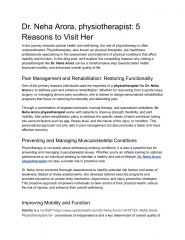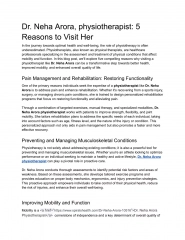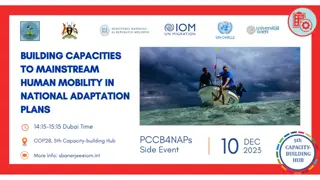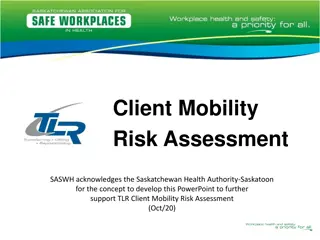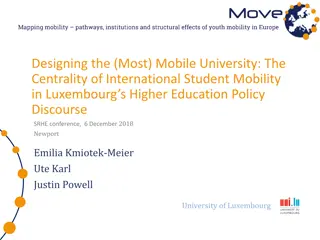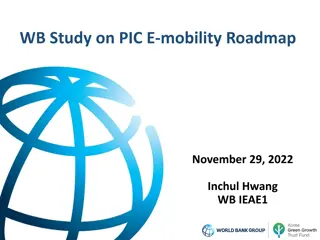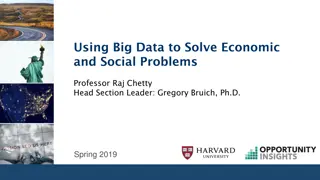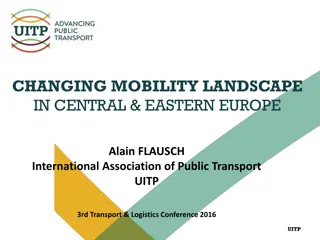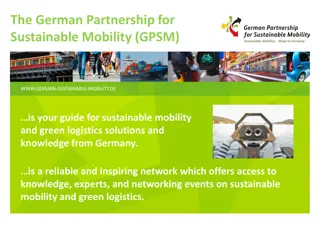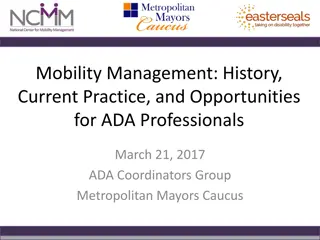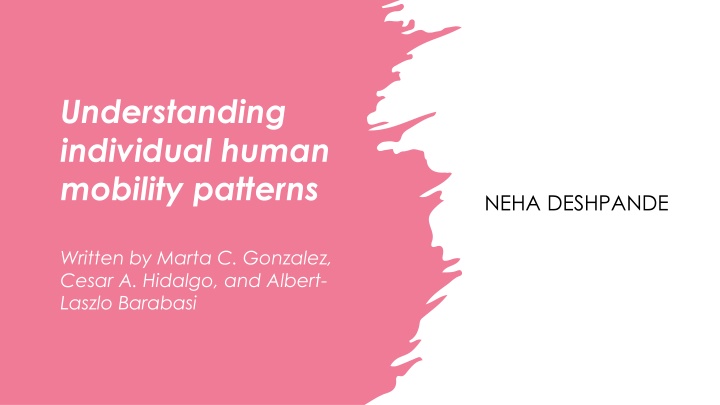
Understanding Individual Human Mobility Patterns and Network Modeling
Explore a study on individual human mobility patterns, network modeling, and Levy flights. The research delves into datasets, motivation, and the implications for urban planning, disease prevention, and emergency response. Discover insights on where people go, how they move, and the network model used in the study.
Uploaded on | 0 Views
Download Presentation

Please find below an Image/Link to download the presentation.
The content on the website is provided AS IS for your information and personal use only. It may not be sold, licensed, or shared on other websites without obtaining consent from the author. If you encounter any issues during the download, it is possible that the publisher has removed the file from their server.
You are allowed to download the files provided on this website for personal or commercial use, subject to the condition that they are used lawfully. All files are the property of their respective owners.
The content on the website is provided AS IS for your information and personal use only. It may not be sold, licensed, or shared on other websites without obtaining consent from the author.
E N D
Presentation Transcript
Understanding individual human mobility patterns NEHA DESHPANDE Written by Marta C. Gonzalez, Cesar A. Hidalgo, and Albert- Laszlo Barabasi
Previous Work Motivation Network Model Datasets Methods and Results Displacement Distribution Radius of Gyration Shape of Individual Trajectories Overview Experiment Datasets Methods Results Future Work 11/14/2022 Understanding individual human mobility patterns 2
Previous Work Bank Notes Animals Keep track of bank note sightings Albatrosses 500,000 bank notes Monkeys Fat-tailed (skewed) displacement Marine predators Levy flight distribution, = 1.59 Levy flight distribution, < 2 Population mobility, not individual movement 11/14/2022 Understanding individual human mobility patterns 3
Levy Flight Levy Distribution Levy Flight High probability of low step size Random walk, step size follows Levy distribution Low probability of high step size (Turning angle is uniformly distributed) 11/14/2022 Understanding individual human mobility patterns 4
Motivation What was the study? How is this helpful? Understanding individual human travel patterns Intra-day Daily Long term Planning city layouts Predicting traffic Emergency response Preventing the spread of diseases Biological infections Electronic viruses Where do people go? Where do they spend their time? Power/telephone line locations How often did people visit different places? 11/14/2022 Understanding individual human mobility patterns 5
Datasets ?? ?? 10,000 randomly-selected individuals 206 individuals 2 weeks 6 months User s cell tower every 2 hours User s cell tower location during a call/text 10,407 displacements 16,264,308 displacements Used to ensure ?1 wasn t biased Used for conducting the study 11/14/2022 Understanding individual human mobility patterns 6
Network Model Modeled as a network Each cell tower is a node Movement between locations is an edge Displacement (edge): movement from one location (node) to another Most people moved within a small area, few people moved hundreds of kilometers 11/14/2022 Understanding individual human mobility patterns 7
Distribution of Displacements Displacement = edge length Truncated power-law shown below Truncated = power-law multiplied by an exponential function Exponential function stabilizes tail skew to compensate for lack of data = 1.75 0.15 (mean standard deviation) Similar to bank note dispersal ?0 = 1.5km K for ?1= 400km, K for ?2= 80km 11/14/2022 Understanding individual human mobility patterns 8
Radius of Gyration Characteristic distance travelled by a user within a certain period of time Distribution of radius of gyration for all users Model = truncated power-law Other possibilities: random walk, Levy flight, truncated Levy flight = 1.65 0.15 (mean standard deviation) ??0 = 1.5km K = 350 km 11/14/2022 Understanding individual human mobility patterns 9
Individual Trajectories Should the radius of gyration increase with time? People are more likely to visit places they have not been to before Individuals split into small (??< 3 km) medium (20 < ??< 30 km) large (??> 100 km) Best fit model: logarithmic Also modeled random walk and Levy flight 11/14/2022 Understanding individual human mobility patterns 10
Location Frequency Peaks Probability that a user returns to the same location repeatedly Low probability of going somewhere new Peak every 24 hours (i.e. at home) Solid line is probability of returning to the same location with a random walk model 11/14/2022 Understanding individual human mobility patterns 11
Location Frequency Model Probability of returning to the same location regardless of time P(L) = 1/L, with L being the rank of the location Rank 1: where they spend most time High probability of returning to somewhere they spend a lot of time Low probability of returning to a place they don t spend a lot of time Logarithmic Axes are logarithmic, so model looks like a straight line 11/14/2022 Understanding individual human mobility patterns 12
Shape of Human Trajectories What is the probability of a user being at a specific (x,y) position? Probability density function spatial anisotropy (density is not circular) anisotropy ratio S y/ x is standard deviation How circular is the data? Rescaled distribution using standard deviation 11/14/2022 Understanding individual human mobility patterns 13
Shape of Human Trajectories S ratio decreases with ?? where = 0.12 S = y/ x = ?? is small Not enough (or biased) data? Is this really a good model? Other models might be better 11/14/2022 Understanding individual human mobility patterns 14
Evaluation Results are consistent with intuition Most likely to spend time at home, work, or school Less likely to go shopping Even less likely to go on vacation More likely to visit places they have been to before Data collection might be biased Inconsistent proximity of cell towers More cell towers = more displacements Someone in a city could move the same amount as someone in a rural area, but register more displacements 11/14/2022 Understanding individual human mobility patterns 15
Experiment How does precipitation affect human mobility? Hypothesis: On rainy days, People will not go outside People will stay at home People will be less likely to go shopping The same probability of going to work and school 11/14/2022 Understanding individual human mobility patterns 16
Google Mobility Dataset https://www.google.com/covid19/mobility/ Breaks up into countries, states, and counties Rensselaer County Splits up into different categories: Grocery & pharmacy, Parks, Transit stations, Retail & recreation, Residential, Workplaces Measured in percent change from baseline for that day of the week Baseline was in 5 weeks of 2020 before the quarantine officially started: Jan 3 - Feb 6 country_region _code country_region sub_region_1 sub_region_2 date retail_and_recreation_perc ent_change_from_baseline US United States New York Rensselaer County 2/15/2020 5 11/14/2022 Understanding individual human mobility patterns 17
Weather Dataset https://www.ncdc.noaa.gov/cdo- web/datasets/GHCND/stations/GHCND:US1NYR N0013/detail National Oceanic and Atmospheric Administration (NOAA) keeps track of weather based on the weather station Troy 6.9 NE Latitude, longitude, elevation, etc. Inches of precipitation STATION NAME LATITUDE LONGITUDE DATE PRCP US1NYRN0013 TROY 6.9 NE, NY US 42.79035 -73.56226 1/4/2020 0.06 11/14/2022 Understanding individual human mobility patterns 18
Data Preprocessing and Experiment Plan Google Mobility dataset Keep only the date and percent changes columns Keep only rows where data was collected in Rensselaer County in 2020 Weather dataset: Keep only date and inches of precipitation Inner join the two datasets on the date (pandas DataFrame) Inner join removes baseline dates Split up into two subsets Inches of precipitation == 0 Inches of precipitation != 0 Graph the two subsets in a bar graph (Matplotlib) 11/14/2022 Understanding individual human mobility patterns 19
Experiment Result Percent change is consistently lower during rain for all categories except Residential Significant difference for Parks Not much difference in Grocery, which is essential Unexpected: lower during rain for transit stations Public transit is better than walking in the rain? Prefer to drive themselves? Data is during quarantine option to work from home How would this be different in non- quarantine times? 11/14/2022 Understanding individual human mobility patterns 20
Future Work Phone s GPS location (latitude, longitude) instead of cell tower Work on modeling individual human trajectory shape Probability distribution of location Compare human mobility in pre-quarantine, quarantine, and post-quarantine times Google Mobility dataset doesn t have anything before Feb 2020 or after October 2022 How will these results impact the real world? Make existing cities more efficient Planning new cities 11/14/2022 Understanding individual human mobility patterns 21
Works cited Paper: https://www.nature.com/articles/nature06958 Image: https://en.wikipedia.org/wiki/L%C3%A9vy_distribution Image: https://en.wikipedia.org/wiki/L%C3%A9vy_flight https://stats.stackexchange.com/questions/208883/what-exactly-is-a-truncated- power-law-distribution Google Mobility dataset: Google LLC "Google COVID-19 Community Mobility Reports". https://www.google.com/covid19/mobility/ Accessed: Nov 8 2022. Precipitation dataset https://www.ncdc.noaa.gov/cdo- web/datasets/GHCND/stations/GHCND:US1NYRN0013/detail Rensselaer County map: https://maps.google.com/ 11/14/2022 Understanding individual human mobility patterns 22

